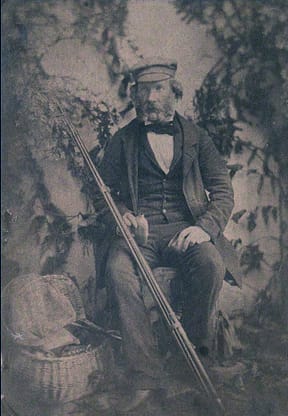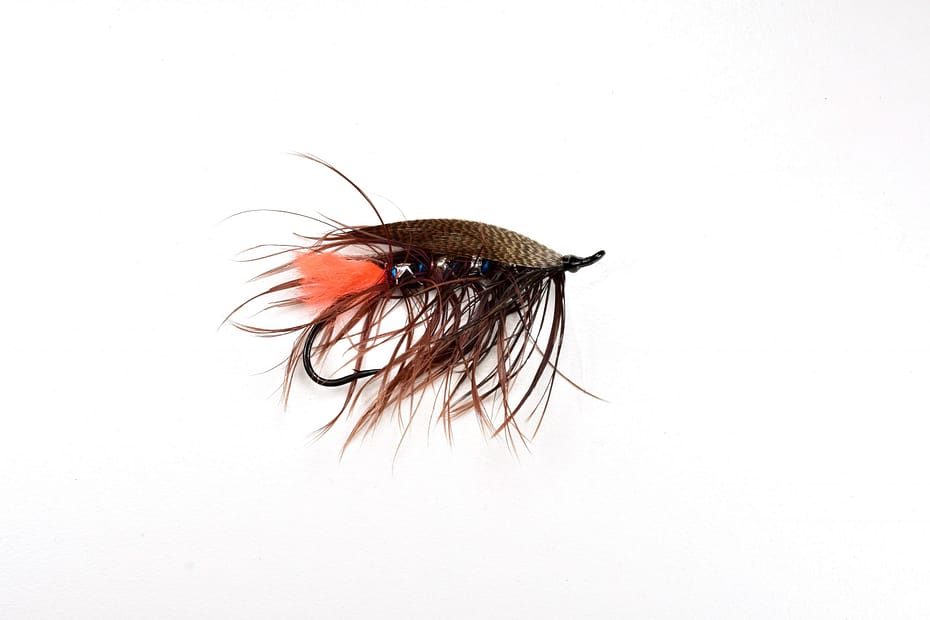Spey Fly History
In his first book, The Art of Angling (1836) Scottish angler and poet, Thomas Tod Stoddart, described several flies used for Atlantic salmon – “While on salmon flies, we may notice some of the most effective kinds for Scottish rivers. These may be reduced to three or four; and first, the professor’s on a large scale, with its mallard wings, yellow silk body, and red or black hackles, only let the hackles be brought down somewhat farther on the hook than is done on the trouting fly.”
Stoddart went on to describe the Professor. He wrote it was an effective trout fly – “Foremost is the fly commonly called the Professor’s, after Professor Wilson of Edinburgh. The wings are formed of a mottled, brown feather, taken from the mallard or wild-drake; the body is of yellow floss silk, rather longish, and wound about close to the head with a fine red or black hackle; tails are often used, but we think them unnecessary.” The Professor fly pattern was credited to Professor Wilson of Edinburgh. This pattern may have been one of the first salmon flies tied with bronze mallard flank feathers as wings. Today, the Professor fly is a popular North American wet fly pattern. However, the fly is typically tied with white speckled mallard breast feathers.
Salmon angling popularity
Equally important, as angling for Atlantic salmon grew in popularity, specific flies were developed for many Scottish rivers. Furthermore, the River Spey was no different. A specific style of tying salmon flies began to become popular in the mid-1800’s. The River Spey is a large river with generally high banks lined with trees. Due this the setting, the river became the birthplace of Spey casting, most often with long two-handed fly rods. Spey casting is a method of fly casting. It is designed to allow the angler to make long casts with little room for a back cast.
Stoddart wrote a later angling book, Angler’s Companion to the Rivers and Locks of Scotland (1847). Regarding Scotch salmon flies he again mentioned using brown mottled mallard feather for the wings. Additionally, he also added a long body hackle – “The flies used I have elsewhere described, but may mention that the most favourite ones are those which are winged with the brown mottled feather taken from the back of the mallard—and having a long-fibred hackle, generally one of those which depend from the breast of the male heron, brown or dun-coloured dubbing, and a strip of fretted tinsel, wound, not too closely, around the body.”

Early Spey Flies
In Angler’s Companion to the Rivers and Locks of Scotland (1847), Stoddart included a table of “Salmon Flies for Various Rivers”. Two flies for the River Spey, No’s 1 and 2. were included in the table with the following tying instructions:
Spey Fly No. 1
Body – Black or brown mohair, or pig’s wool mixed; hackle taken from the pendant breast of a male heron, broad gold or silver lace, lapped on widely
Wing – Brown feather taken from the back of a mallard
Tail Tuff – Yellow or orange
Observations – A soft long fibred hackle or side feather from barn-fowl cock or hen is sometimes employed instead of the heron hackle. A thread of blue silk is frequently introduced, wound on next to the lace.
Spey Fly No. 2
Spey fly No. 2 is similar to No. 1 except calls for a body of black mohair; black hackle; and silver tinsel; and the wing is “a pair of crest feathers taken from golden pheasant.”
Later, other English anglers and writers added additional specific salmon fly patterns for fishing the River Spey. Francis Francis wrote A book on Angling (1867). It included three Spey flies: the Spey Dog, Purple King and Green King. Each of these flies called for a “large black feather, with a lightest dun tip, taken from the side of a Scotch cock’s tail”. It was dressed so the hackle stands out abruptly. The wings were “a good wad of golden pheasant tail with two long strips of grey mallard with brownish tips over it”.
A few years later, Arthur Edward Knox described several old Spey flies in his book Autumns on the Spey (1872). Knox wrote – “Spey Flies, properly so-called, are simple and unassuming in both composition and appearance.”
Spey Fly observations
In particular, Knox liked the way they moved in the river. Furthermore he made an observation “while lying down on the bank of a small clear pool, at the tail of a rush of water through one of the arches of Spey Bridge, near Fochabers, and attentivity watching the motions of a fly at the end of a long line thrown by a young friend of mine – an accomplished flyfisherman – from the parapet above. Its undulating movements under the water exactly resembled those of a living shrimp or prawn, while the continuous play of the long soft hackles of the heron or fowl – so characteristic of the old Spey fly – imitated so closely the actions of those small, but many legged crustaceous animals, I had frequently observed them in the aquarium of the Zoological Society”.
Knox original list
Knox’s original list of old Spey flies included 16 patterns. Moreover the list included: the Gold Speal, Silver Speal, Gold Reeach, Silver Reeach, Gold-Green Reeach, Silver-Green Reeach, Gold-Green Fly, Silver Green Fly, Green King, Purple King, Black King, Gold Purple Fly, Culdrain Fly, Gold Heron, Black Heron and Carron Fly.
“Speal” was Scottish for a small splinted of wood; the “King” patterns were characterized by alternating bands of gold and silver tinsel; and the word “Reeach” or “Riach” is Sottish for dun or drab.


In addition to the old Spey flies of A. E. Knox, later, early tiers added additional Spey-type patterns including the Dallas and Lady Caroline. Through the following decades early writers continued to add to the lore and Spey Fly History including J.H. Hale, How to Tie Salmon Flies (1892), George M. Kelson, The Salmon Fly (1895), T.E. Pryce-Tannatt, How to Dress Salmon Flies (1914). Recent reviews of the history, materials and origin of Spey flies can be found in John Shewey’s Spey Flies and Dee Flies: Their History and Construction (2002), and the late Bob Veverka’s Spey Flies – How to Tie Them (2004).
Spey fly variations
Fly tyers have offered variations of original Spey flies. One notable individual was Sydney “Syd” Glasso (1906 – 1983). Glasso lived in Forks, Washington and fished steelhead rivers in and around the Olympic Peninsula. He was an accomplished angler and fly tyer routinely use paired hackles as wings. His flies also incorporated long palmered body hackles similar to original Spey flies for his winter steelhead patterns. As a result his creations have been described as Spey flies. Unfortunately, the only similarity is the use of the long body hackles.
Glasso wrote one article published in the December, 1970, issue of The Creel, the newsletter of The FlyFishers Club of Oregon. In the article he indicated “I like Spey type flies for winter steelheading and have used them for over twenty years. The style is over a century old, they’re easy to tie and they look seductive in the water. The fish take them solidly and that’s enough for me.” It is very likely Glasso also tied traditional Spey patterns as described by Knox and others. In addition to his feather wing steelhead patterns, Glasso also tied beautiful fully dressed Atlantic salmon flies.
Spey fly pictures
Pictures of Glasso’s feather wing patterns first appeared in a black and white photograph in Trey Comb’s The Steelhead Trout (1971). Color photographs of Glasso’s files were latter illustrated in Comb’s second book, Steelhead Fly Fishing and Flies (1976) and again in his third steelhead book Steelhead Fly Fishing (1991). Specifically describing Glasso’s style, the late Doug Rose (1950 – 2013) wrote in his On the Water Log, September 11, 2008 – “In particular, Glasso wanted mobility in his flies and he thought that feathers accomplished that better than hair. Walter Johnson, one of the first Puget Sound fly fishers to embrace Glasso’s flies, has written that was also the reason Glasso replaced the traditional flat, bronze mallard flank wing of Scottish Speys with upright hackle-tip wings”.
Furthermore, Dave McNeese wrote a two-part article about Glasso in Swing the Fly, 2018 Volumes 2 and 3. The articles include information about Glasso’s life and flies, and included several photographs of his flies. Modern tyers, including Dave McNeese, Steve Gobin, John Shewey, Sean Dahlquist and the late Bob Veverka have embraced Glasso’s style. Fortunately, they have contributed many beautiful new fly patterns to steelhead fishing.
Feather hackle wings
In conclusion, the use of feather hackles for wings on flies has been around for many decades. Finally the style was used on many Atlantic salmon patterns and on some early Northeast flies for landlock salmon. Paired feather hackle wings have also been used for several Northern California summer steelhead flies. These included the “Silver Hilton”, credited to Henry Hilton sometime in the 1920’s or 1930’s; the “Donnelly Partridge”, created in the 1930’s by Roy Donnelly, a California fly tyer; and the “Joe O’Donnell”, a pattern that featured paired Badger hackle wings. However, none of these patterns incorporate a palmered body hackle. In all instances, the wings were splayed out as opposed to tented over the body.
Steelhead flies constructed with either paired bronze mallard slips or long saddle hackles for wings continue to be effective for steelhead. Tying Spey flies is not difficult but having an understanding of their construction can be helpful.
For further reading, click on the blogs below:
Unique Things You Need to Know-Historical Spey Fly Construction – Part 2
